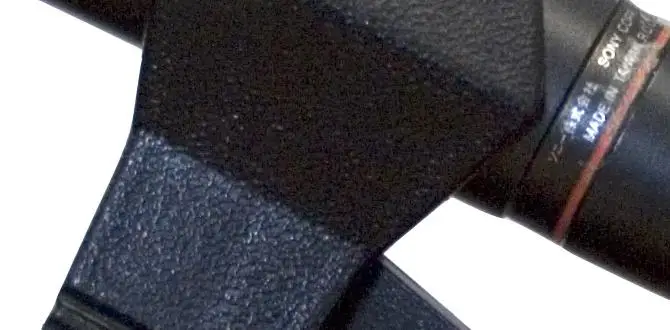Quick Summary: Use a TV size calculator for room wall mount by measuring viewing distance and desired screen size for optimal comfort. This guide simplifies choosing the perfect TV dimensions and wall mount placement, ensuring an immersive home theater experience without eye strain.
Thinking about mounting your TV? It’s a fantastic way to save space and create a sleek, modern look. But before you drill that first hole, there’s a little planning to do. Choosing the right TV size for your room and ensuring it’s mounted at the perfect height and distance can feel like a puzzle. Get it wrong, and you might end up with a screen that’s too small to enjoy or too big for your comfortable viewing. Don’t worry, we’re going to break it all down, step-by-step, so you can confidently pick the ideal TV size and mount it like a pro.
Why Your Room Size Matters for TV Mounting
It’s easy to get dazzled by the latest, biggest TV screens. But a giant TV crammed into a tiny living room can be overwhelming, while a small TV lost on a massive wall might feel underwhelming. The key is balance. Your room’s dimensions and the distance you’ll be watching from are the most important factors in determining the ideal TV size. Buying a TV that’s too large for your space can lead to discomfort. Your eyes will have to dart back and forth to take in the whole picture, which can cause strain. On the flip side, a TV that’s too small won’t deliver that cinematic feel you might be going for.
Understanding Viewing Distance: The Golden Rule
The most crucial element in choosing your TV size is the viewing distance. This is simply the space between your couch (or primary viewing chair) and where the TV will be. Get this right, and you’re halfway to a perfectly immersive experience. Too close, and you’ll see individual pixels or experience eye fatigue. Too far, and you might miss the fine details.
How to Measure Your Viewing Distance
This is super simple!
- Grab a tape measure.
- Sit on your couch or favorite viewing spot.
- Have someone else stand where your TV will be mounted, or simply estimate the distance from your eyes to the wall where the TV will hang.
- Measure the straight-line distance from your seating position to the TV’s intended spot on the wall.
Recommended Viewing Distances for Different TV Sizes
To help you out, here’s a general guideline for recommended viewing distances, based on common TV screen sizes. These are great starting points, but personal preference can always play a role!
When we talk about TV size, we’re referring to the diagonal measurement of the screen, from corner to corner. A 65-inch TV, for example, has a screen that measures 65 inches diagonally.
| TV Size (Diagonal) | Recommended Minimum Viewing Distance | Recommended Maximum Viewing Distance |
|---|---|---|
| 32 inches | 3.2 feet (1 meter) | 6.4 feet (2 meters) |
| 40 inches | 4 feet (1.2 meters) | 8 feet (2.4 meters) |
| 50 inches | 5 feet (1.5 meters) | 10 feet (3 meters) |
| 55 inches | 5.5 feet (1.7 meters) | 11 feet (3.3 meters) |
| 65 inches | 6.5 feet (2 meters) | 13 feet (4 meters) |
| 75 inches | 7.5 feet (2.3 meters) | 15 feet (4.6 meters) |
| 85 inches | 8.5 feet (2.6 meters) | 17 feet (5.2 meters) |
These are based on a viewing angle of roughly 30-40 degrees, which is comfortable for most people when watching regular TV content and movies. For a more cinematic, immersive experience (like you’d get in a movie theater), you might prefer a slightly closer distance, which corresponds to a wider viewing angle, sometimes up to 40-50 degrees. For Ultra HD (4K) content, you can often sit closer without noticing pixels, so you might lean towards the smaller end of these ranges or even a bit closer for larger TVs.
Using a TV Size Calculator: What It Does
A TV size calculator is a handy online tool that takes your room measurements and viewing distance to suggest the ideal TV screen size. It helps bridge the gap between knowing your room’s dimensions and picking the perfect TV.
Benefits of Using a TV Size Calculator
- Optimizes Viewing Experience: Ensures you get a TV size that’s just right for your space, preventing eye strain and maximizing immersion.
- Saves Money: Helps you avoid overspending on a TV that’s too big or regretting buying one that’s too small.
- Reduces Decision Fatigue: Simplifies the overwhelming choice of TV sizes available.
- Provides Confident Recommendations: Offers data-driven suggestions tailored to your specific needs.
How to Use a Typical TV Size Calculator
Most online TV size calculators are straightforward. You’ll usually need to input:
- Viewing Distance: The measurement you took earlier.
- Room Width/Length (Optional): Some calculators might ask for this to give more context.
- Desired Immersion Level: Some calculators ask if you prefer a standard view or a more cinematic, enveloping experience.
Based on these inputs, the calculator will provide a recommended minimum and maximum TV size in inches.
Where to find them: Many major electronics retailers and tech review websites offer free TV size calculators. A quick search for “TV size calculator” will bring up plenty of options. For example, CNET often has helpful tools like this.
Mounting Your TV: Height and Placement Considerations
Once you’ve chosen the perfect TV size based on your room and viewing distance, the next step for wall mounting is figuring out the ideal height and placement. This is just as important as the TV size itself for comfortable viewing and a great aesthetic.
Finding the Perfect TV Mount Height
The general rule of thumb for TV mounting height is to have the center of the screen at eye level when you are in your primary viewing position. This ensures you don’t have to crane your neck up or hunch down to see the picture comfortably.
Here’s how to find that sweet spot:
- Sit Down: Get into your usual viewing position on the couch or chair.
- Eye Level: Have a friend measure the distance from the floor to your eye level.
- Adjust for Mount: This eye-level measurement is where the center of your TV should be. Keep in mind that wall mounts can place the TV a few inches above or below this exact point, so you might need to consider the thickness of your TV and the specific mount’s capabilities.
- Account for TV Size: For very large TVs, you might bring the center slightly lower than strict eye level to ensure the top of the screen isn’t too high. The goal is always relaxed viewing.
Considerations for Different Room Types
Living Rooms
For most living rooms, the eye-level rule is perfect. You’ll typically be mounting the TV above a fireplace or a media console. If mounting above a fireplace, be mindful of the heat and the extreme height. Often, mounting above a console is more ergonomic. Aim for the bottom of the TV to be about 10-20 inches above the console for good spacing.
Bedrooms
In a bedroom, you’re usually watching TV from a bed. This means your eye level will be from a reclined position. You might need to mount the TV slightly higher than you would in a living room, but still ensuring eye level is at the center of the screen when you’re lying down.
Kitchens/Dining Areas
Mounting a TV in these areas often means viewing from different distances and angles. Consider where people will be standing or sitting most often. You might opt for a slightly higher mount to be out of the way, but always test the viewing angle from common spots.
Types of TV Mounts
Choosing the right mount depends on your needs and preferences:
Fixed Mounts
These hold the TV flat against the wall, like a picture frame. They are the slimmest and often the most affordable.
- Pros: Minimalist look, very secure, low profile.
- Cons: No adjustability in angle or position after installation.
Tilting Mounts
Allow you to tilt the TV up or down. This is useful if your TV is mounted slightly higher than eye level, or to reduce glare from room lights.
- Pros: Reduces glare, good for slightly higher mounting positions.
- Cons: Can add a few inches to the TV’s distance from the wall compared to fixed mounts.
Swiveling/Articulating Mounts
These offer the most flexibility, allowing you to tilt, swivel, and extend the TV away from the wall. Great for rooms where you watch from multiple angles or want to tuck the TV away when not in use.
- Pros: Maximum adjustability, ideal for corner mounting or variable viewing positions.
- Cons: Can be more expensive, may leave the TV further from the wall when extended.
Low-Profile Mounts
A subset of fixed mounts designed to get the TV as close to the wall as physically possible, creating a very sleek, integrated look.
Tools You’ll Need for Mounting
Before you start, make sure you have the right tools. Safety first!
- Stud Finder: Essential for locating wall studs, which are necessary for secure mounting. Drywall alone is not strong enough.
- Drill and Drill Bits: For pilot holes and driving screws.
- Level: Crucial for ensuring your TV is mounted straight.
- Tape Measure: For measuring distances and ensuring proper placement.
- Pencil: For marking wall locations.
- Socket Wrench or Screwdriver Set: To tighten bolts and screws.
- Wall Anchors (if not mounting into studs): Use only heavy-duty, appropriate anchors for your wall type if studs aren’t available (though studs are always preferred).
- Wall Mount Kit: The mount itself and its included hardware.
Important Note on Wall Types: Most TV mounts are designed to be attached to wooden studs within drywall. If you have concrete or brick walls, you’ll need specific masonry anchors and potentially different drill bits. Always consult the mount manufacturer’s instructions for your specific wall type. For guidance on identifying studs, resources from organizations like Building Science Corporation can offer valuable insights into construction practices.
Step-by-Step: How to Mount Your TV
Mounting a TV can seem daunting, but by following these steps, you can do it safely and effectively.
Step 1: Locate Wall Studs
Use your stud finder to locate the center of at least two wall studs where you plan to mount the TV. Mark the edges and center of each stud. Most mounts need at least two studs for secure attachment.
Step 2: Position the Mount Bracket
Hold the TV mount’s wall plate against the wall at your desired height (remember, center of the screen at eye level). Use your level to ensure it’s perfectly straight. Mark the screw hole locations on the wall through the bracket.
Step 3: Drill Pilot Holes
Drill pilot holes at the marked locations. The size of the pilot hole should match the screws provided with your mount, or as recommended by the manufacturer. Ensure you are drilling into the center of the studs.
Step 4: Attach the Wall Bracket
Align the wall bracket with the pilot holes and secure it firmly using the lag bolts provided. Tighten them using a socket wrench until the bracket is snug and immovable against the wall. Do not overtighten, as this can strip the wood.
Step 5: Attach the TV Brackets
Attach the mounting arms or brackets to the back of your TV. These usually attach to the VESA mounting holes on your TV. Make sure you use the correct-sized screws and any necessary spacers provided with your mount kit. Do not overtighten these screws.
Step 6: Hang the TV
With the help of another person, carefully lift the TV and hook the brackets on the TV onto the wall plate. There’s usually a mechanism (like a screw or clip) to secure the TV to the mount, preventing it from being accidentally dislodged. Consult your mount’s manual for this specific step.
Step 7: Connect Cables and Test
Plug in your HDMI, power, and other cables. Turn on the TV and check that it’s level and securely attached. Adjust the viewing angle if you have a tilting or articulating mount.
Common Mistakes to Avoid When Calculating and Mounting
Even with a guide, it’s easy to stumble. Here are some common pitfalls:
- Ignoring Viewing Distance: This is the #1 mistake. A TV that is too big or too small for the distance will compromise the experience.
- Mounting Too High: The “fireplace mount” is a classic example of mounting too high, leading to neck strain.
- Not Finding Studs: Mounting into drywall alone is a recipe for disaster. Always find studs or use appropriate heavy-duty anchors for your wall type.
- Using the Wrong Screws: Using screws that are too short or too long can lead to an unstable mount. Always follow the manufacturer’s recommendations.
- Forgetting Cable Management: Visible cables can ruin the sleek look. Plan for how you’ll hide them during the mounting process.
- Not Using a Level: A crooked TV is distracting. Always use a level during installation.
Frequently Asked Questions (FAQ)
What is the ideal viewing distance for a 65-inch TV?
For a 65-inch TV, a recommended viewing distance is typically between 6.5 feet (2 meters) and 13 feet (4 meters). For a more immersive, cinematic experience with 4K content, you might prefer to be closer, around 6.5 to 8 feet.
Can I mount a TV on a wall without studs?
Mounting directly into drywall without studs is unsafe for most TVs. You must find wall studs for secure mounting. If studs are not an option, professional installation or heavy-duty concrete/masonry anchors (for concrete walls) are necessary. Always prioritize mounting into studs for safety and stability.
How high should I mount my TV?
The general rule is to mount the center of the TV screen at eye level when you are seated in your primary viewing position. For most living rooms, this means the bottom of the TV might be around 30-40 inches from the floor, but this can vary significantly based on your furniture and seating height.
What is VESA?
VESA is a standard for the mounting interfaces on flat-panel TVs and monitors. It refers to the pattern of mounting holes on the back of your TV. Most TV mounts are VESA-compatible, meaning they will fit TVs with standard VESA patterns (e.g., 200x200mm, 400x400mm). Check your TV’s manual for its VESA pattern.
Do I need to consider glare when mounting my TV?
Yes, glare can be a significant issue. When deciding on placement and mount type, consider the direction of windows and light fixtures in your room. A tilting or articulating mount can help you adjust the TV’s angle to minimize glare. Sometimes, repositioning the TV slightly on the wall can make a big difference.
How much weight can a TV wall mount hold?
TV wall mounts are rated for maximum weight capacities. Always check the mount’s specifications and ensure it can safely support the weight of your TV. Newer, larger TVs can be quite heavy, so it’s crucial to pick a mount rated well above your TV’s weight for a safety margin.
What’s the difference between a TV size calculator and a mount calculator?
A





